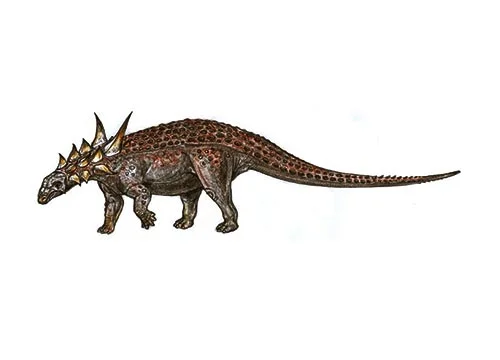Antarctopelta (Antarctic shield)

An-tarc-toe-pel-tah
Leonardo Salgado & Zulma Gasparini - 2006
Herbivore
Estimated 4 meters long
Armoured Dinosaur
A. oliveroi (type)
Antarctica - Santa Marta Formation
Late Cretaceous, 74-70 million years ago
Antarctopelta Facts
Antarctopelta (/aen,ta:rktoU’pelt@/ ann-TARK-toh-PEL-t@; meaning ‘Antarctic shield’) was a genus of ankylosaurian dinosaur with one known species, A. oliveroi, which lived in Antarctica during the Late Cretaceous Period.
The Holotype (specimen which is the base to determine this taxon) is the only specimen of this genus and species, and is the first dinosaur to be discovered in Antarctica. It is comprised of three distinct teeth, a portion of the jaw’s lower part, with an additional tooth present along with other skull fragments and vertebrae (neck back, back, hips and tail) and bone fragments from the limbs (scapula, ilium, and the femur) the toe bone (five metapodials as well as two Phalanges) and a variety of parts of armour.
The skeleton appears to be damaged, since several of the bones that are closest close to each other were exposed to years of fractures caused by freezing and weathering.
Antarctopelta oliveroi was named in 2006 by Argentine paleontologists Leonardo Salgado and Zulma Gasparini. It is the second genus named of dinosaurs found in Antarctica, following Cryolophosaurus.
The name genus is a reference to its position in the Antarctic continent Antarctica and its armored appearance. The only species that is known, A. oliveroi, is named in honor of Eduardo Olivero, who discovered the holotype first, and then mentioned in printed works.
Earlier research suggested that the James Ross Island ankylosaur was one of the juvenile, but new research has revealed that the various components of the vertebrae have been connected, and an adult would expect to show visible sutures connecting the neuroarch and the body (centrum) of vertebrae. A preliminary analysis of histology of a number of bones indicates an amount of change that cannot be observed in the newly formed bone.
Antarctopelta oliveroi was a quadruped with a large, herbivore body with armored plates encased in the skin. It is believed to have had an average measurement of 4 meters (13 feet) from the snout up to the tail tip and a higher estimate of 6 meters (20 feet) and 350 kilograms (772 pounds). A small portion of the skull is known, but the majority of skull bones were deeply ossified to provide protection.
The leaf-shaped teeth are asymmetrical and the vast majority denticles situated on the side closest to the top of the snout. Six different kinds of osteoderms were identified together with the bones from Antarctopelta, but only a few were articulated with the skeleton.
They were found at an element at the bottom of what could be a massive spike.
Antarctopelta was an ankylosaurid that had an unflat, frond-like tail structure that resembled macuahuitls, similar to the one of Stegouros the closest close relative. It was composed of oblong plates, polygonal nodules, oval-shaped osteoderm, and ossicles. Vertebrae were found near the tip of the tail during life and were found to be ossified tendon both on the lower and upper sides. The presence of large osteoderms and specially-designed tail vertebra show that Antarctopelta might have had a unflat tail structure.



